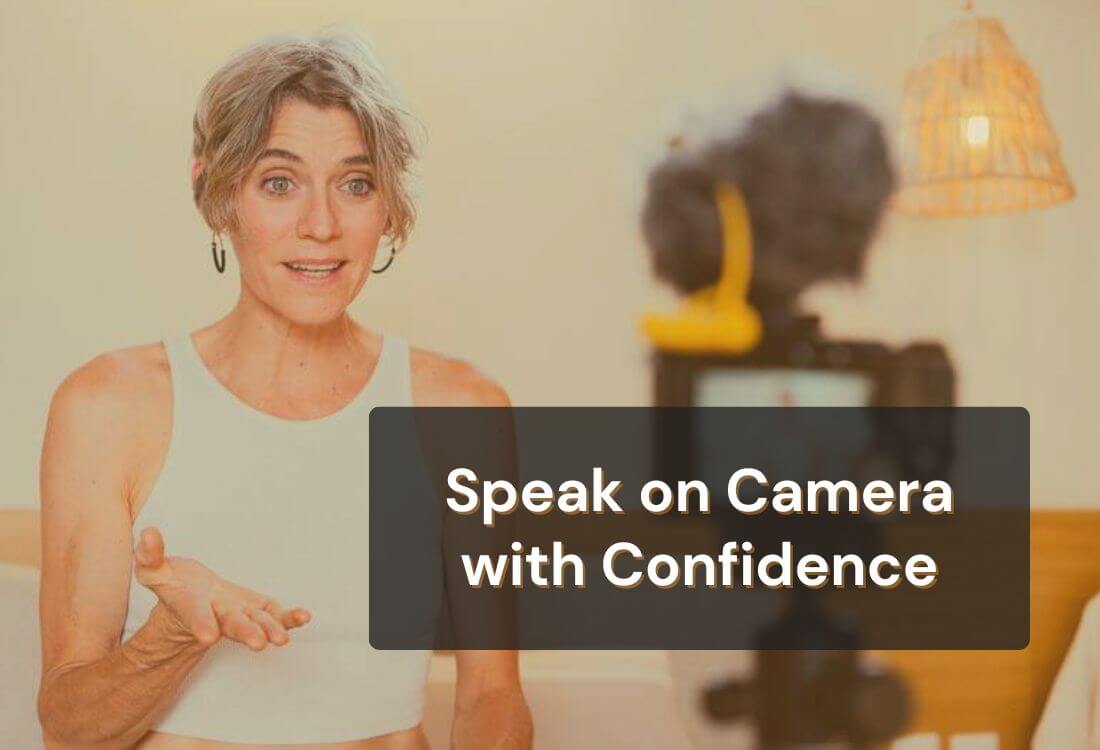



Speaking on camera is a skill that can open doors, whether you’re creating online courses, hosting webinars, filming YouTube videos, or leading virtual meetings. Video is projected to make up about 82% of global internet traffic by 2025.
But for many people, appearing confident and natural in front of the camera doesn’t come easy. The good news? You can train this skill just like any other.
This guide breaks down five practical tips on how to speak on camera with confidence, authenticity, and control, plus a few pro insights to help you sound and look your best every time you hit record.
Speaking on camera has become an essential skill for anyone who communicates through video. From hosting webinars and leading virtual meetings to recording social media content or online lessons, how you present yourself on screen shapes the way your audience interprets your message.
Mastering how to speak on camera helps you project confidence, clarity, and warmth. It allows you to engage viewers on a personal level, earn their trust, and share your ideas with greater impact. A steady tone, natural expression, and composed presence all contribute to how effectively your message lands.
This ability isn’t limited to content creators or public speakers. It’s valuable for professionals, educators, and entrepreneurs alike, anyone who wants to express their thoughts with confidence and authenticity. With consistent practice and the right approach, you can turn initial camera anxiety into ease and deliver messages that feel genuine and persuasive.

You’re not talking to the camera. You’re talking to the person watching your video, you’re having a conversation. And just like an in-person conversation, you need to make eye contact to engage your audience.
As such, when you’re recording a video, look directly into the lens of the camera when you want to make your strongest points. Your audience will feel that you’re looking right at them, and the message will come across as almost personal - which is what you want. However, there is some nuance to this.
Too much eye contact can make anyone uncomfortable. Looking directly into the camera during your entire video will do the same thing. As such, it’s beneficial to look in the vicinity of your camera - close but not direct. This will come across as eye contact, but not the intense stare brought about by looking into the lens.
To achieve a natural balance between looking at the camera and looking away while speaking naturally on video, observe your natural conversational habits. During your next in-person conversation, pay attention to how long you maintain eye contact before feeling uncomfortable. You can then apply this observation to your next video recording to appear more natural on camera.

Don’t focus so much on getting your point across that you forget to include body language in your video. According to Mehrabian’s Communication Theory, what we say only makes up 7% of the message we’re trying to say. The other 97% is how we say it both in our inflection and body language. So, put emotion into what you’re saying - not just with your words but with your body.
Similar to eye contact, you can study how to apply body language on video from your day-to-day life. Consider how you move naturally during a conversation. You can then apply what you learn from your video. It is only a matter of mindful observation.
There are very few content creators ad-libbing their content. The pros you see out there have planned that dialogue, researched that topic, and, most of all, practiced it beforehand! Always know what you’re going to say before you even sit in front of the camera. Otherwise, you’re going to find yourself struggling to edit together a cohesive final product. A well-thought-out video is always easier for post-production.
Also, rehearsing before recording will help you relax on camera. That will cut the stress out of what you need to say, and you’ll appear more confident to your audience in the process.
A common mistake new content creators make is saying, “I want to be like the host from my favorite podcast!” But you’re not the host of your favorite podcast. You’re you, and that’s the most important thing you can be when you get in front of a camera.
Putting on a personality or an act for the camera risks coming across as disingenuous and putting off your potential audience. Rather, successful creators utilize their true selves to make the content they are passionate about and engage an audience looking for that kind of connection. That connection with your audience is essential for your growth as a creator and for reaching a larger audience.
Ever wonder how professional presenters deliver their lines flawlessly without missing a beat? They’re likely using a teleprompter app.
A teleprompter helps you stay on track, maintain eye contact, and deliver your script smoothly, without looking down at notes or stumbling through sentences.
Here’s how to use a teleprompter effectively:
Try Teleprompter.com, a professional yet user-friendly teleprompter app that lets you record directly from your device while reading your script. It’s perfect for beginners creating vlogs, tutorials, or presentation videos.
A teleprompter is your best on-camera ally to improve your on-camera presence, making you look confident, polished, and professional.

Speaking confidently on camera often means tackling a few hurdles—like nervousness, distractions, or mistakes. Here’s how to handle them effectively:
Feeling anxious before filming is completely normal. It’s a sign that you care about how your message comes across. To calm your nerves, try deep breathing or visualization techniques before hitting record. Imagine yourself speaking confidently and maintaining control of your tone and pace. You can also warm up by practicing short introductions to ease into the session. Over time, regular filming desensitizes fear and builds on-camera composure.
Distractions can quickly break your focus and throw off your rhythm. Create a distraction-free recording space, choose a quiet room, silence notifications, and make others aware of your filming schedule. Close unnecessary tabs or apps to reduce mental clutter. A clean, focused environment lets you stay present and express yourself naturally on camera.
Even professionals make slips or forget a word mid-sentence. Instead of stopping and restarting every time, pause, take a breath, and pick up from your last point. Minor stumbles make you appear more human and authentic, which audiences actually appreciate. If needed, small edits in post-production can polish your video without sacrificing its genuine feel.
Learning how to talk to the camera takes time, patience, and consistent practice, but the payoff is huge. When you develop camera confidence, you’ll communicate with impact, connect more deeply with your audience, and project professionalism in every video you make.
Remember these camera confidence tips:
With these strategies, you won’t just look confident on camera, you’ll feel confident. And that’s what truly makes your message shine.
Practice speaking conversationally, maintain eye contact with the lens, and use a teleprompter app to keep your tone relaxed and authentic.
It feels unnatural because there’s no real-time feedback. Anxiety, self-consciousness, and lack of practice make it harder to sound confident.
Prepare your script, rehearse often, and start with short recordings. Confidence grows as you become comfortable seeing yourself on video.
Reading word-for-word, avoiding eye contact, and using a monotone voice can make your delivery sound stiff and less engaging.
Warm up before recording, speak slowly, and use natural variations in pitch and tone to sound clear, confident, and engaging.



